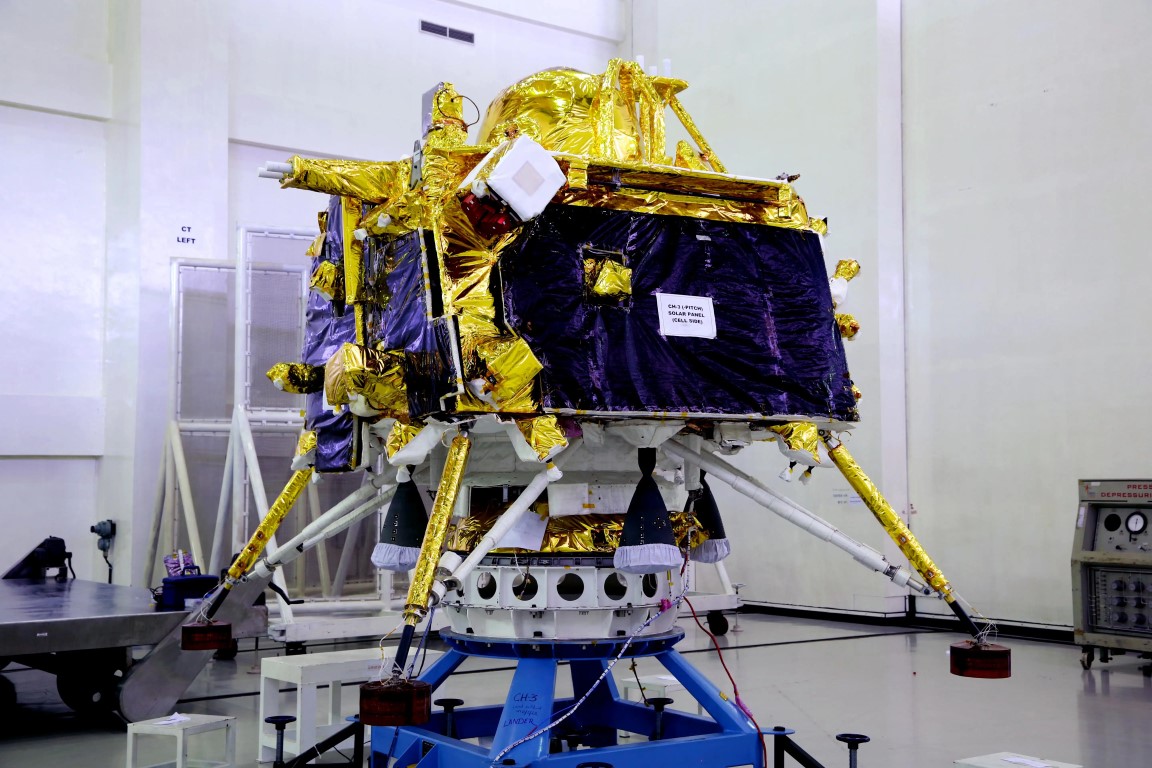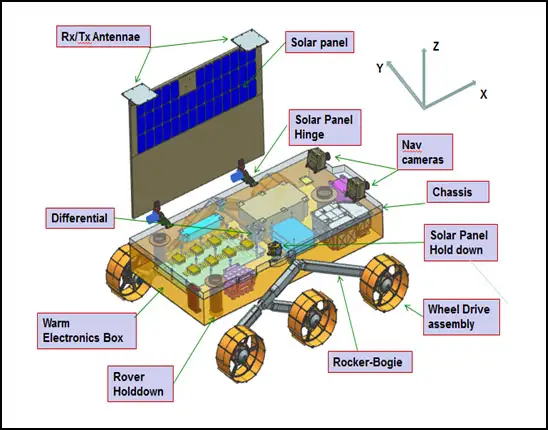Chandrayaan-3 is a follow-on mission to Chandrayaan-2 to demonstrate end-to-end capability in safe landing and roving on the lunar surface. It consists of Lander and Rover configuration. It will be launched by LVM3 from SDSC SHAR, Sriharikota. The propulsion module will carry the lander and rover configuration till 100 km lunar orbit. The propulsion module has Spectro-polarimetry of Habitable Planet Earth (SHAPE) payload to study the spectral and Polari metric measurements of Earth from the lunar orbit.
Updates of Chandrayaan-3 Mission

The Indian Space Research Organisation (ISRO) scripted history as Chandrayaan-3 spacecraft made a soft landing on the surface of the Moon Wednesday evening. The Vikram lander made the soft landing at 6.04 PM (IST), ending the disappointment over the crash-landing of the Chandrayaan-2 lander four years ago.
With the mission’s success, India has become the first country to land a spacecraft in uncharted territory near the lunar south pole. In fact, India is only the fourth country in history to complete a soft landing on the Moon after the United States, the Soviet Union and China.
Shortly after the Vikram lander landed and its health was assessed by the space agency, the dust settled on the lunar surface and the Pragyan rover rolled out of the lander. With this, the Chandrayaan-3 mission’s 14 days of science observations has begun. ISRO chief S Somanath added that ISRO will be working on a robotic path planning exercise that could aid future exploration of the Moon.
An Overview of the Chandrayaan-3 Mission Life and Technicalities

Chandrayaan-3, the successor of the Chandrayaan-2 mission, is a meticulously planned mission by India to further explore the lunar terrain. Scheduled to operate for the duration of one lunar day, equivalent to around 14 Earth days, the mission’s primary landing site covers an area of 4 km x 2.4 km located at 69.367621 S, 32.348126 E on the Moon’s surface.
In terms of equipment and payload, the lander is fitted with multiple scientific instruments including RAMBHA, ChaSTE , ILSA, and LRA . The rover, accommodated within the lander, boasts of APXS and LIBS. The propulsion module comes with SHAPE
This mission incorporates a two-module configuration, with a propulsion module responsible for transporting the lander from launch injection to lunar orbit, and a separate lander module that houses the rover. The total mass for the mission is 3900 kg, with the propulsion module weighing 2148 kg and the lander module, inclusive of the 26 kg rover, weighing 1752 kg.
Power generation for the modules varies 758 W for the propulsion module, 738W (WS with Bias) for the lander, and 50W for the rover. Communication protocols are also distinct. The propulsion module communicates directly with IDSN, while the lander maintains communication links with both IDSN and the rover. There is also a planned contingency link with the Chandrayaan-2 Orbiter. The rover, on the other hand, communicates exclusively with the lander.
Understanding Chandrayaan-3’s Science and Working
3.1 Lander Payloads: RAMBHA, ChaSTE, ILSA, LRA
3.2 Rover Payloads: APXS and LIBS
3.3 Propulsion Module Payload: SHAPE
3.1 The Lander:

- RAMBHA (Radio Anatomy of Moon Bound Hypersensitive ionosphere and Atmosphere): Using a tool named Langmuir probe (LP), RAMBHA aims to measure tiny charged particles (like ions and electrons) right above the Moon’s surface. It will check how these particles change over time.
- ChaSTE (Chandra’s Surface Thermo physical Experiment): This tool will study the Moon’s surface temperature, especially near the poles. Think of it as a super-advanced thermometer.
- ILSA (Instrument for Lunar Seismic Activity): ILSA is like a mini earthquake detector but for the Moon. It’ll see how much the ground shakes near where it lands, helping us understand what’s going on deep inside the Moon.
- LRA (LASER Retroreflector Array): This one’s a bit different. It’s a passive tool that will help scientists better understand the movement and dynamics of the Moon.
3.2 The Rover:

- LIBS (LASER Induced Breakdown Spectroscope): Imagine a tool that can look at Moon rocks and dirt and tell you what they’re made of. LIBS will do just that, helping us know more about the Moon’s composition.
- APXS (Alpha Particle X-ray Spectrometer): Similar to LIBS, APXS will examine the Moon’s soil and rocks to figure out the elements they contain, like magnesium, aluminum, and iron, to name a few.
3.3 The Propulsion Module:

- SHAPE (Spectro-polarimetry of Habitable Planet Earth):
This tool is looking far ahead to the future. It’s set to help us discover smaller planets by reflecting light. By doing so, scientists hope to find planets that might be suitable for life.
In simpler words, Chandrayaan-3 has tools to study the Moon’s surface, its inner activities, and even tools that look beyond the Moon in hopes of finding new, habitable worlds.
Equipment Used in Chandrayaan-3
To achieve the mission objectives, several advanced technologies are present in Lander such as,
- Altimeters: Laser & RF based Altimeters. It can measure height with lasers and radio frequencies.
- Velocimeters: Laser Doppler Velocimeter & Lander Horizontal Velocity Camera.It has special speed measuring
- Inertial Measurement: Laser Gyro based Inertial referencing and Accelerometer package. It uses top-notch tech to measure its movement and position.
- Propulsion System: 800N Throttleable Liquid Engines, 58N attitude thrusters & Throttleable Engine Control Electronics.Its propulsion system is strong with engines that can change direction and strength
- Navigation, Guidance & Control (NGC): Powered Descent Trajectory design and associate software elements.It has super-smart navigation systems for a smooth landing
- Hazard Detection and Avoidance: Lander Hazard Detection & Avoidance Camera and Processing Algorithm. It can even detect dangers and avoid them using cameras and special software. And, of course, it has legs designed to land safely.
From Lunar Landings to Future Ventures India’s Expanding Horizons

Currently, Chandrayaan-3’s landing on the Moon isa proud moment for India in its space exploration journey. This event highlights India’s scientific skills and strong will to learn more about space. This mission doesn’t just add a new story to India’s space tales but also brings new chances and growth in space technology for the nation.
Looking ahead, it’s clear that India has many more space adventures planned. With missions like Aditya-L1 on the horizon, tests for Gaganyaan, plans for Chandrayaan-4, and ideas for exploring Mars and Venus, there’s a lot to be excited about. With the success of Chandrayaan-3, India shows that the sky isn’t our final goal. Instead, it’s just the start as we aim to learn more and more about space.
Image Source: ISRO
